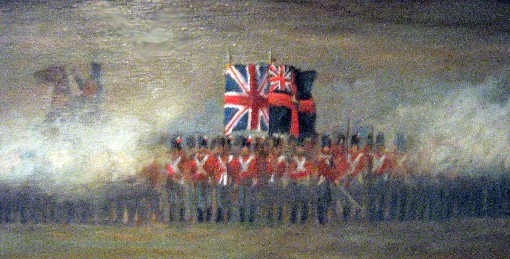Our
sites:
Home
of
Access Heritage Inc (formerly The Discriminating General)
The
Seven Years War Website
The
Napoleonic Wars Collection
The
War of 1812 Website
The
General's Arms Collection
The
Victorian Soldier
Military
Heritage Magazine
Military
Music Sound Clip Gallery
Military
Video Clip Gallery
Products
and Services:
Our
Mission and Clients
Product
Index
Heritage
Film Services
Seven
Years War Products
Amer.
Revolution Products
Napoleonic
Wars Products
French
Napoleonic Headdress
British
Army Products 1793-1815
British
Army Products 1816-1856
Artillery
Helmets
and Armour
Military
Buttons
Military
Belt Plates
Muskets,
Bayonets
Swords
Sword
Knots
Military
Drums and Bugles
Gifts,
Collectibles
War
of 1812 Prints
18th
Century Maps
Additional
Products..
|

Articles
- Reenactments
and Units - Book
Reviews - Quizzes
-
Replicas
- Links
- Chart
of British Regiments - Sound
Clips - Prints
for Sale - Animated
GIF Battles - Chronology
of Events - Video
Clips
The
Colours (or Flags) of the 89th Regiment
of Foot
by Kevin Windsor

89th Colours at Crysler's Farm
(painting by Sherriff-Scott/ photo by Rene Chartrand)
The
89th Regiment of Foot was raised by Major General William
Crosbie in December 1793. In
January of 1794, the Regiment embarked for
England
under the command
of Lieutenant Colonel Charles Handfield.
It was probably at the
Southampton
that the 89th
received there first set of Colours.
1st
Set
These Colours were carried only for a brief period of time.
Presumably from 1794 until 1801 with the Act of Union, where they
were replaced with a set with the Cross of St. Patrick.
It was originally thought that this set was lost in 1805, but there
is a pre 1801 Regimental Colour in the
Royal
Irish
Fusilier
Museum
in
Armagh
, which is assumed
to be from this set. The
Number on it is LXXXVIIII. It
is not known who presented them.
2nd
Set
These Colours are speculative, but since the pre 1801 Colours are
in the
R.
I.
F.
Museum
it is certain that
a new set was issued after 1801, but before 1805.
These Colours were lost in a shipwreck on
December 13, 1805
, when the Regiment
left
Kinsale
,
Ireland
to go on active
service in
Holland
.
The Regiment lost most of its head quarters, including the band,
mess plate, Regimental books and many lives.
The Dutch made prisoners of those who were not drowned.
3rd
Set
Nothing is known about this set, but with the addition of the 2nd
Battalion of the 89th Regiment in December 1803, they received
their own set. The 2nd
Battalion carried these Colours during the War of 1812 at the Battles of
Crysler’s Farm, Lundy’s Lane. They were laid up in November 1816 on
the reduction of the 2nd Battalion.
4th
Set
Between June and September of 1806 the 1st Battalion of
the Regiment received their third set of Colours at
Ospringe
,
England
.
There is no record as to who presented these Colours, but while in
Ospringe the Regiment was reviewed by HRH the Duke of York before
embarking again on active service and twenty-one years in
India
.
5th
Set
On
the 6th
November 1816
the remaining
soldiers of the 2nd Battalion 89th Regiment marched
to Quilon with the 1st Battalion where the Regiment remained
for 15 years. On
May 17th
1820
the Regiment
received a new set of Colours. This
set of Colours were probably presented by Lord Rawdon (1754-1826) who was
the Governor General of
India
and the Commander
in Chief of the Forces in
India
.
These Colours were carried through the Burmese War and were carried
by the Regiment went they were awarded the battle honour “Ava” in
1826.
6th
Set
On
January 13, 1831
, after 21 years,
the 89th Regiment left
India
and sailed to
England
arriving on
the 7th
of May 1831
after an absence of
twenty-five years. The
Regiment marched from
Chatham
to
Canterbury
and boarded the
Ships “Tallavera” and “Wellesley” for
Plymouth
, and finally
arrived on November 22nd at Devonport where they remained on
Garrison duty for nearly two years. During
this time the Regiment received their 6th Set of Colours.
On
the 3rd
of August 1833
, General Lord Hill
of Waterloo fame inspected the 89th Regiment on the Plymouth
Hoe, and the fourteen-year-old, Heir Presumptive, Princess Victoria
presented the Colours to the Regiment.
This set of Colours was carried by the Regiment for 33 years (20
years being on Foreign Service) and was taken to the
West Indies
,
Canada
, the
Crimea
,
South Africa
, and again to
India
.
They are currently housed in the Garrison Church (All Saints) in
Aldershot
.
7th
Set
On the 8th of August 1865, the Regiment, again, return
to
Great Britain
after an absence of
thirty years. The Regiment
arrived in Shorncliffe with 12 companies and a strength of 723 all ranks.
On
March 29 1866
, the Regiment was
moved by rail to
Aldershot
.
On
April 5, 1866
the Regiment
presented with, what would become, their last set of Colours.
It is rare in history that a set of Colours is replaced by the same
person who bestows the first. But
on that day at
3 p.m.
Victoria
, this time as Queen
presents the 89th Regiment with a new set to replace those she,
as Princess, presented 33 years earlier.
This set was carried by the Regiment for 15 years and were laid up
when the Regiment was localised with the 87th Royal Irish
Fusiliers to become the 2nd Battalion Royal Irish Fusiliers
(Princess Victoria’s) and later Princess Victoria’s (Royal Irish
Fusiliers) Regiment.
Copyright:
Kevin Windsor 2006

Contacting
us
Copyright:
Unless otherwise noted, all information, images, data contained within this website is
protected by copyright under international law. Any unauthorized use of material
contained here is strictly forbidden. All rights reserved.
|



